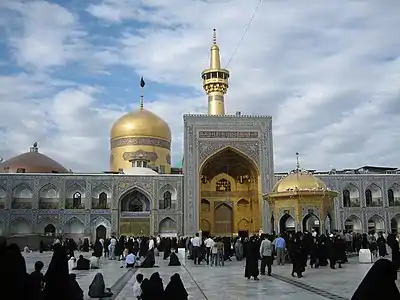
The zarih in the Al-Askari Shrine which surrounds the graves of Hasan al-Askari, Ali al-Hadi, and Narjis Khatun

The large wooden zarih built over the grave of Muhammad ibn Idris al-Shafi'i before the renovation.
A zarih (Persian: ضَرِیح, Urdu: ضَرِیح, Hindi: ज़रीह) or ḍarīḥ (Arabic: ضَرِیح) is a lattice structure which usually encloses a grave in a mosque or an Islamic shrine.[1] In some cases, it can also surround a religious relic on display.
A zarih is built by skilled craftsmen. It can be made out of metals such as silver, or it can be made of wood. The structures can be the size of a small room.[2]
Notable zarih can be found in the Imam Husayn Shrine, the mosque of Imam Ali, and the Shrine of Abdul Qadir al-Jilani.

A zarih surrounding a grave which is claimed to be that of biblical Daniel, Tomb of Daniel, Susa, Iran.
See also
References
This article is issued from Wikipedia. The text is licensed under Creative Commons - Attribution - Sharealike. Additional terms may apply for the media files.









%252C_2014.JPG.webp)





